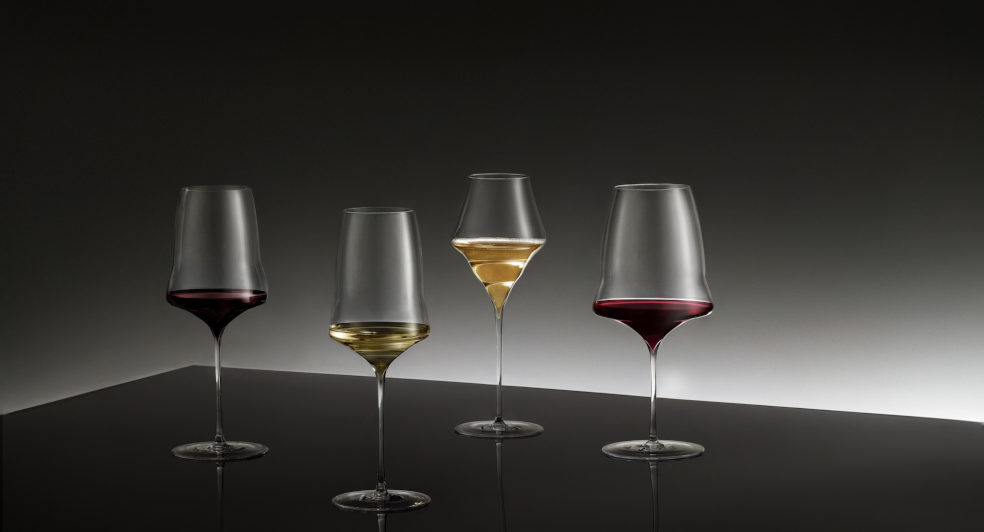More Than Meets The Glass! Haute Couture Wine Glass Designer, Kurt Joseph Zalto, Breathes New Life Into The Iconic Josephinenhütte Brand
31st August 2023

Glassware is to wine what bubbles are to Champagne: ESSENTIAL.
For a glass to be in complete accord with the wine, size and shape inherently come into play.
The right glass will allow for the individuality and unique personality of a wine to be fully expressed and revealed.
Perhaps no one knows this better than esteemed glass designer Kurt Josef Zalto – a man who needs no introduction to wine aficionados. Hailed far and wide as a virtuoso, Zalto is perhaps the greatest glass artist of our times. His name alone instantly evokes images of finesse and quality. His absolute commitment to craftmanship tradition and pristine sophistication have catapulted his designs to stratospheric success and has become a benchmark against which other high-end stemware can be measured.
Rooted in history, the Zatlo glass tradition commenced in the 18th century during the crystal scene in Veneto, Italy, when in 1770 his ancestors emigrated to Austria.
For six generations, the Zalto family has worked as the leading artisanal glassmakers in Lower Austria’s Neunagelberg, a major wine region. Kurt Jospeh Zalto first learned the craft from his father before going on to complete his academic formation at the glass school in Kramsach and at the Nachtmann Company in Germany.
Today the world-renowned artisan continues to work his magic with his latest artistic venture becoming the creative director of the prestigious Josephinenhütte.
The stunning award-winning glass collection is inspired by history. The story begins in 1842 in central Europe when founder, Count Leopold von Schaffgotsch, named the company after his wife Josephine. Once one of the most significant glassworks in Europe and the New World, the formidable success story of the historical Josephinenhütte ended a century later falling into complete obscurity over the decades.
Cut to 2019 when the revolutionary Austrian glass designer decided to inject new blood into the Silesian glassware techniques and breathed a new life into the Josephinenhütte brand.

The result is an exceptional work of art with the design of Zalto’s JOSEPHINE series of glasses.
Four elegant wine glasses – each representing a unique mouth-blown and handmade piece – that provide a new dimension in taste. Organically formed and featuring a distinctive kink, the world’s finest and incomparable glasses allow the aroma of the wine to unfold to the fullest. Their visionary shape and uncanny lightness give the sensation the wine is floating in your hand – for an even better, more intense, and authentic taste experience and with greater fidelity.
I was fortunate to be contacted by Zalto’s PR team who sent me both the Champagne glass (the JOSEPHINE No 4) with a gently sloping angle, a slender bowl and deeply pointed tip at the bottom, and the white wine glass (The JOSEPHINE No 1). There is also a red wine glass with voluptuous curves to amplify Burgundian reds and a universal glass for all occasions.
As both a sparkling wine expert and the most devout Champagne aficionado, I was pleasantly surprised to experience how Zalto’s spill-proof Champagne glass genuinely made the wine taste better than most other glasses. An experience unlike any others … holding a piece of art in your hands that feels like you’re hardly holding anything at all.
Adorning tables all around the world, Zalto’s masterpiece glasses have already been adopted by some of the most notable sommeliers as a paragon of excellence – the holy grail of glassware.
It was a great honor to be given the opportunity to interview Kurt Joseph Zalto about his iconic visionary wine glasses and the legacy of his craftsmanship.
1) The Zalto glass family tradition has roots dating back to the Venetian crystal era. Can you briefly retrace the history of the Zalto glassware dynasty?
“My family’s history and tradition go back well into the 18th century to Veneto, Italy when my ancestors emigrated to Austria. I learned the art of glass from my father and uncle, and later refined it at the glass school in Kramsach with the help of my mentor Alfred Puchinger, director of Nachtmann in Neustadt a.d. Waldnaab, Germany.”
2) The art of glassmaking has been passed on in your family from generation to generation, what attracted you to the craft?
“I was born with a passion for glass. As a 4-year-old boy, I was in and out of my father’s studio intrigued by the craft. The heat of the furnace, the red-hot glasses coming out of the wooden forms, the focus, and the precision and craftsmanship have always fascinated me. At eleven years old I was sketching designs and in the 80s I started to release my first glass under my family name.”
3) With your reputation and notoriety, what inspired you to revive the iconic Josephinenhütte glassware studio? What is it about the story of this historical studio that drew you in?
“Josephinenhütte was a Silesian glassworks in the Sudeten Mountains, founded in 1842 by Count Leopold von Schaffgotsch and named after his beloved wife Josephine. At the time glassmaker Franz Pohl, head of Josephinenhütte, and a gifted creator and artistic pioneer, went beyond the boundaries of what was thought possible in glassmaking by creating glass objects of technical sophistication and absolute beauty. This made the historic Josephinenhütte one of the most significant glassworks in Europe and the New World. Unfortunately, it perished and the former splendor of the brand fell into obscurity. A century later in 2019, I wanted to bring the name Josephinenhütte back. The heritage of the brand, its pursuit of excellence and innovation is what drew me to become part of the company, as well as our mutual aim to create glasses that are functional, sophisticated, delicate yet robust.”
4) In your opinion, what defines the Josephinenhütte standard of excellence?
“The functionality of the glasses depends on the shape and the balance, as well as the lead-free crystal glass material. Only the best glassmakers are able to achieve this high quality and even then we need to melt a significant amount of glasses as they do not fulfill our quality requirements. Looking at all the precision and work that goes into each glass it saddens me every time to see functionally perfect glasses being melted in the oven again because of little bubbles in the glass. For me, little bubbles are proof of craftsmanship but in our world, this is not accepted anymore. “
5) Any wine aficionado and/or expert knows the importance of glassware when it comes to best experiencing wine. Knowing that the shape of a glass shapes the taste of the wine, how did you come up with the design of the 4 glasses you released under the Josephinenhütte label?
“In my experience, the importance of glass is still underrated and even among sommeliers. In the process of designing one glass for both burgundy and Bordeaux, I rediscovered the relationship between man and object for a totally new shape. For more than 30 years I have been researching how liquids behave in glass. In addition, I take inspiration from nature and I am fascinated by its many shapes which are always functional. There is a reason for the shape of every living organism and this was the moment when I set out to design the Josephine collection.”
6) All your wine glasses share a conical base and slight ripple in the design, what is the reasoning behind the concept?
“The reason was the development of a new functional shape to optimize the taste of wine linked to the fascination with beauty. The kink is visually striking, but it’s there to allow the wine more movement as it flows back into the glass after every sip. The spiral movement helps oxygenate the wine, allowing the flavors to develop faster and more fully. The glass provides the platform for the wine to reveal its full potential.”
7) Let’s talk a little bit about your technique – you hand blow each stem and shape each bowl by hand. Can you elaborate on your artisanal process?
“Our mouth-blown, handmade wine glasses are made one at a time with lead-free crystal glass. What many underestimate is how difficult it is to get this quality of glass. There are so many factors influencing the glass that some days the glass clarity is not sufficient for our glasses. To create the bowl, molten glass is inflated into a bubble by a glassblower using a pipe and then blown into a wooden mold. With our metal tools, the stem is manually pulled from the bowl while additional glass is added to form the base. In order to get the flexibility and reduce breakage our glasses are then slowly cooled down in the lehr, cut and then polished, weighted and checked before being packaged.”
8) What legacy do you hope to leave behind?
“I hear from sommeliers, winemakers and wine lovers that my glasses have changed their wine drinking experience. And if my legacy is changing the wine world with my glasses, this would be more than what I could have dreamed of as a little boy in my father’s glassworks.”
9) Is there a question I have not asked, you wish I had asked you; and if yes, which one and why?
“You know, I am a very lucky guy. I work on beautiful things and I meet many people who are very passionate about culinary delights. So, if you asked me what I like about my job? I would answer you: to travel the world, sit together with passionate people, enjoy a great wine, eat great food and talk about wine, food, art, music, history, politics or soccer. And then return to my home and have tranquility in the forest, walk my dogs and spend time with my family.”
Josephinenhütte is available for purchase in the U.S. at https://us.josephinen.com
![]()
Mona Elyafi
Founder of ILDK Media, a boutique Public Relations and Digital Communications agency. Champagne specialist, educator, writer & consultant. She has WSET Level 2 Award in Wines certified and also Champagne Master Level by the Wine Scholar Guild.
